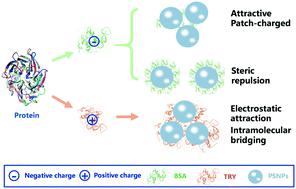当前位置:
X-MOL 学术
›
Environ. Sci.: Nano
›
论文详情
Our official English website, www.x-mol.net, welcomes your
feedback! (Note: you will need to create a separate account there.)
Protein corona-induced aggregation of differently sized nanoplastics: impacts of protein type and concentration
Environmental Science: Nano ( IF 5.8 ) Pub Date : 2021-4-14 , DOI: 10.1039/d1en00115a Xing Li 1, 2, 3, 4 , Erkai He 3, 4, 5, 6 , Bing Xia 4, 7, 8 , Yang Liu 4, 9, 10, 11 , Peihua Zhang 1, 2, 3, 4 , Xinde Cao 1, 2, 3, 4 , Ling Zhao 1, 2, 3, 4 , Xiaoyun Xu 1, 2, 3, 4 , Hao Qiu 1, 2, 3, 4
Environmental Science: Nano ( IF 5.8 ) Pub Date : 2021-4-14 , DOI: 10.1039/d1en00115a Xing Li 1, 2, 3, 4 , Erkai He 3, 4, 5, 6 , Bing Xia 4, 7, 8 , Yang Liu 4, 9, 10, 11 , Peihua Zhang 1, 2, 3, 4 , Xinde Cao 1, 2, 3, 4 , Ling Zhao 1, 2, 3, 4 , Xiaoyun Xu 1, 2, 3, 4 , Hao Qiu 1, 2, 3, 4
Affiliation

|
Nanoplastic contamination is one of the pressing environmental concerns globally. Among many environmental factors in aquatic systems, ubiquitous proteins are expected to affect the physicochemical properties of nanoplastics and subsequently influence their fate, transport, and toxicity. Here, time-resolved dynamic light scattering was used to investigate the comparative effects of negatively charged bovine serum albumin (BSA) and positively charged bovine trypsin (TRY) on polystyrene nanoplastic (PSNP) aggregation. The critical coagulation concentrations (NaCl) of 20 and 100 nm PSNPs decreased from 311 and 361 mM to 10 and 43 mM after interacting with TRY, respectively, mainly due to the additional electrostatic attractive force and intramolecular bridging. The attachment efficiencies of BSA–PSNP conjugates decreased from 1 to 0 with increasing electrolyte concentration, suggesting that the patch-charge attractive force may be screened by steric repulsion. At a relatively high level of protein (>10 mg L−1), PSNPs remained stable in BSA solution, but aggregated quickly in TRY solution. Results clearly showed that the aggregation of nanoplastics was highly related to the electrical charge of the proteins. Compared with 100 nm PSNPs, BSA stabilized 20 nm PSNPs more effectively, whereas TRY destabilized 20 nm PSNPs more effectively, indicating that the smaller PSNPs (20 nm) were more susceptible to the co-occurrence of proteins. This work highlighted the necessity of accounting for the protein type and particle size when evaluating the aggregation state and potential risk of emerging nanoplastics in aquatic systems.
中文翻译:

蛋白质电晕诱导的不同尺寸纳米塑料的聚集:蛋白质类型和浓度的影响
纳米塑料污染是全球紧迫的环境问题之一。在水生系统的许多环境因素中,普遍存在的蛋白质预计会影响纳米塑料的理化性质,并随后影响其命运,运输和毒性。在这里,时间分辨动态光散射用于研究带负电的牛血清白蛋白(BSA)和带正电的牛胰蛋白酶(TRY)对聚苯乙烯纳米塑料(PSNP)聚集的比较作用。与TRY相互作用后,20和100 nm PSNP的临界凝结浓度(NaCl)从311和361 mM分别降低到10和43 mM,这主要是由于额外的静电吸引力和分子内桥联所致。随着电解质浓度的增加,BSA-PSNP共轭物的附着效率从1降低到0,这表明可以通过空间排斥来筛选贴片电荷吸引力。相对较高的蛋白质水平(> 10 mg L-1),PSNP在BSA溶液中保持稳定,但在TRY溶液中迅速聚集。结果清楚地表明,纳米塑料的聚集与蛋白质的电荷高度相关。与100 nm PSNP相比,BSA更有效地稳定了20 nm PSNP,而TRY更有效地使20 nm PSNP不稳定,表明较小的PSNP(20 nm)更容易同时存在蛋白质。这项工作强调了在评估聚集状态和水生系统中出现的新兴纳米塑料的潜在风险时,必须考虑蛋白质的类型和粒径。
更新日期:2021-05-06
中文翻译:

蛋白质电晕诱导的不同尺寸纳米塑料的聚集:蛋白质类型和浓度的影响
纳米塑料污染是全球紧迫的环境问题之一。在水生系统的许多环境因素中,普遍存在的蛋白质预计会影响纳米塑料的理化性质,并随后影响其命运,运输和毒性。在这里,时间分辨动态光散射用于研究带负电的牛血清白蛋白(BSA)和带正电的牛胰蛋白酶(TRY)对聚苯乙烯纳米塑料(PSNP)聚集的比较作用。与TRY相互作用后,20和100 nm PSNP的临界凝结浓度(NaCl)从311和361 mM分别降低到10和43 mM,这主要是由于额外的静电吸引力和分子内桥联所致。随着电解质浓度的增加,BSA-PSNP共轭物的附着效率从1降低到0,这表明可以通过空间排斥来筛选贴片电荷吸引力。相对较高的蛋白质水平(> 10 mg L-1),PSNP在BSA溶液中保持稳定,但在TRY溶液中迅速聚集。结果清楚地表明,纳米塑料的聚集与蛋白质的电荷高度相关。与100 nm PSNP相比,BSA更有效地稳定了20 nm PSNP,而TRY更有效地使20 nm PSNP不稳定,表明较小的PSNP(20 nm)更容易同时存在蛋白质。这项工作强调了在评估聚集状态和水生系统中出现的新兴纳米塑料的潜在风险时,必须考虑蛋白质的类型和粒径。











































 京公网安备 11010802027423号
京公网安备 11010802027423号